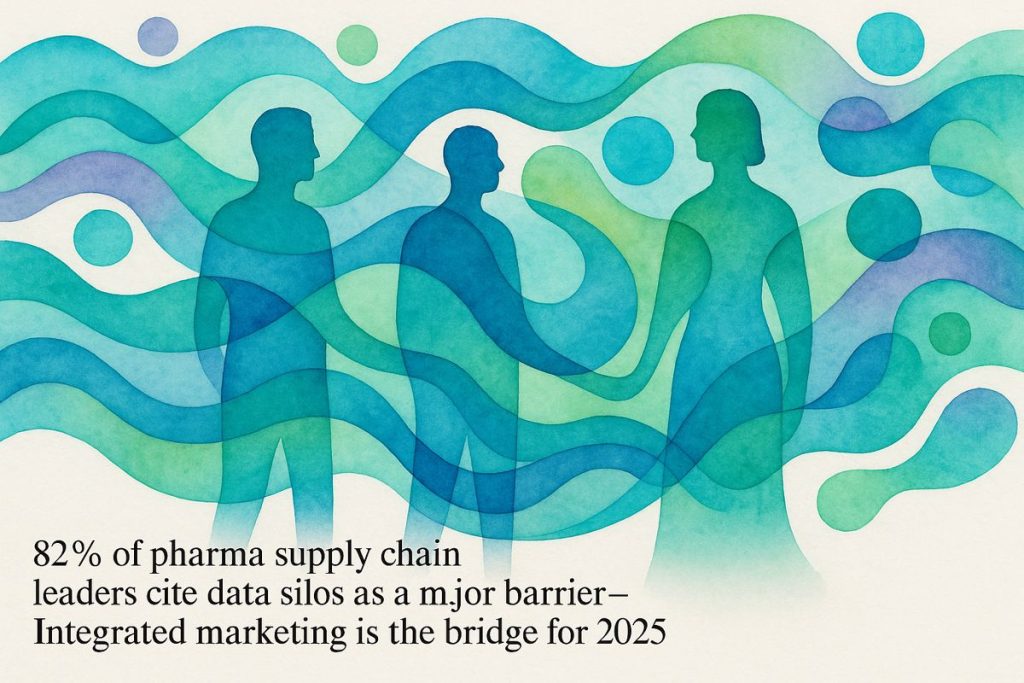In 2025, pharma companies are finally breaking down the walls between their departments, letting marketing, sales, R&D, and supply chain work together. With the help of smart tech like AI platforms, they are sharing data and ideas in real time, making their teams faster and more creative. When people from different areas join forces, they can spot new trends, solve problems quickly, and put patients first. The companies that learn to connect everything will lead the industry, while those who stick to old ways might be left behind.
What are the key trends in integrated marketing for pharma companies in 2025?
In 2025, integrated marketing in pharma is defined by breaking down data silos, embracing AI-driven platforms, and fostering collaboration across marketing, sales, R&D, and supply chain. Companies leveraging unified data, digital tools, and cross-functional teams gain agility, competitive edge, and improved patient-centric strategies.
Silos, Silos Everywhere
Pharmaceutical and life sciences companies are riddled with silos. It’s like walking through a labyrinth constructed by Kafka after three espressos—every department walled off, each with its own secret stash of data, ambition, and, occasionally, existential dread. Did you know that a mere 50% of Chief Marketing Officers (CMOs) actually get a seat at the big strategic planning table? That’s right. The rest are left to polish tactical PowerPoints while the real decisions are made elsewhere. I’ve been there, watching the meeting invites go to everyone but marketing—ugh, the indignity.
This isn’t just a matter of bruised egos. When marketing is disconnected from sales, supply chain, and R&D, opportunities for customer-centric leaps evaporate like the scent of strong coffee left too long in the pot. Recent stats are striking: 82% of pharma supply chain leaders cite fragmented systems and data silos as wrecking balls for end-to-end visibility (PharmExec). That means marketing, so often the canary in the coal mine, can’t even see the coal.
If you’re curious whether this separation is just an organizational quirk—no, it’s a global phenomenon. From Pfizer’s Manhattan headquarters to a Roche R&D hub in Basel, the silos persist. The smell of old paper files? Pervasive, oddly comforting, and a symbol of the analogue inertia that still plagues even the most digitized operations.
Platforms and Palimpsests: Tech to the Rescue
The cavalry, such as it is, arrives in the form of integrated business planning (IBP) and hyperspectral data platforms. Salesforce, SAP—these aren’t just buzzwords, they’re the new lingua franca of pharma’s digital agora. They stitch together the patchwork: operations, finance, marketing, even those prickly regulatory affairs folks. The result? Marketing finally gets its hands on the same data that sales and R&D have been hoarding for decades (Tredence).
Artificial intelligence is no longer just a shiny bauble. Picture AI as a kind of digital synapse, firing across previously unbridgeable gaps and serving up real-time insights that would make even Sherlock Holmes envious. Amgen, Sanofi, Bristol Myers Squibb—these aren’t just names to drop at conferences. They’re pioneers, leveraging AI to juice both R&D and commercial operations. When Amgen rolled out an AI-powered forecasting tool, the operational tempo picked up like a jazz quartet after midnight: unpredictable, but thrilling all the same.
I’ll admit, I once doubted the value of yet another dashboard. But after watching a cross-functional team at Sanofi turn a potential supply chain snafu into a case study in agility—well, let’s just say I ate my words, and they tasted a bit like humble pie.
Breaking Down the Walls: The Human Element
Data and software are vital, sure. But what really moves the needle? People. When marketing is folded into strategic planning (and isn’t just the last stop before product launch), organizations catch subtle shifts in the patient zeitgeist. Suddenly, you’ve got campaigns that don’t just land, they resonate—like a well-tuned violin in a silent hall. The emotional payoff? Exhilaration, mostly, laced with a touch of fear. After all, change is often a rickety ladder to climb.
Let me spin a quick story: Last year, at a mid-tier pharma firm, I watched as a marketer, a data analyst, and a supply chain manager—three unlikely musketeers—hammered out a launch strategy over the world’s worst office coffee. Their collaboration led to a pinpoint response to a sudden regulatory shift in Belgium. The lesson: when silos crumble, serendipity sneaks in.
But not all companies are there yet. Too many still treat marketing as an afterthought, a sort of decorative parsley on the operational steak. That’s risky. By ignoring marketing’s ability to decode the patient journey and anticipate market shocks, organizations invite their own obsolescence. Cue the distant, ominous sound of a ticking clock.
Integration as a Competitive Edge
The future? It belongs to the integrators. The companies with the gumption to dissolve boundaries and let marketing, sales, R&D, and supply chain intermingle (sometimes awkwardly, always productively). AI-powered command centers, digital twin models, and unified CRM platforms aren’t just shiny toys—they’re the scaffolding for commercial excellence. The industry is pivoting, and those who fail to join the dance risk being left in silence.
Strategic investments are surging: data, digital capabilities, AI—all aimed at building resilience and real-time agility (ZS). Yet, there’s a catch. Marketing’s involvement is still catching up. The leading edge? That’s where patient-centric insights, extracted by marketing, drive not just product launches but the entire value proposition.
And if you’re hungry for more, the likes of PM360, Infomineo, Morningstar, and PwC are serving up deep dives, trend forecasts, and enough case studies to keep your inner geek caffeinated for weeks.
So—will 2025 be the year pharma marketing finally tears down the walls? I’m cautiously optimistic. Then again, I’ve been wrong before…
